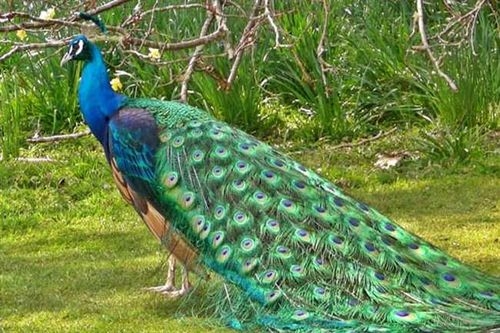The blue peafowl, also known as the Indian peafowl, is a magnificent bird renowned for its vibrant plumage and extravagant tail display. Native to the Indian subcontinent and Southeast Asia, these captivating creatures inhabit tropical and subtropical forests.

Physical Characteristics:
-
Size: Blue peafowl are large birds, measuring 100 to 180 cm in length, including the tail. Males are typically larger than females.
-
Plumage: Adorned with an array of dazzling colors, the blue peafowl’s feathers are a true spectacle. The body is predominantly iridescent blue-green, interspersed with patches of brown and black. The most striking feature is the long, resplendent tail, which can reach up to 2 meters in length. Tail feathers boast a mesmerizing pattern of iridescent blue-green adorned with shimmering blue, yellow, and red ocelli. These eye-catching spots are formed by microscopic structures on the feathers that refract light, producing the unique sparkling effect.
-
Crest: Blue peafowls sport a small crest on their heads, composed of numerous erect feathers. The crest typically appears in shades of blue or green and is often regarded as a symbol of elegance and nobility.
-
Beak and Feet: The blue peafowl possesses a short, stout black beak. Their feet are also black and relatively long, enabling them to navigate the ground with ease.
Behavior:
-
Blue peafowls are social birds, living in flocks. Each flock typically consists of 20-30 individuals, with a dominant male.
-
These birds are omnivorous in their diet. They primarily consume fruits, seeds, insects, and small animals.
-
Blue peafowls are celebrated for their elaborate tail displays. Males fan out their magnificent tails to attract females. The tail display also serves as a means for males to assert their dominance and territorial claims.
-
Breeding occurs seasonally for blue peafowls. The breeding season typically takes place in spring and summer. Each female blue peafowl can lay 4-10 eggs.
Significance:
-
Blue peafowls hold significant cultural symbolism in various countries. They are often associated with beauty, good fortune, and prosperity.
-
Economically, blue peafowls also hold value. Their tail feathers are utilized in crafting jewelry, garments, and decorative items.
-
These birds play a vital role in the forest ecosystem. They help control insect and small animal populations while dispersing seeds.
Conservation Status:
-
Currently, blue peafowls face threats from hunting and habitat loss. Consequently, they are classified as Near Threatened on the IUCN Red List.
-
Conservation efforts are underway to protect blue peafowls. Protected areas are established to safeguard their habitat, and educational programs raise awareness about the importance of conserving this species.
Blue peafowls are captivating creatures, embodying beauty, elegance, and cultural significance. By working together, we can ensure that these magnificent birds continue to grace our planet with their splendor for generations to come.





